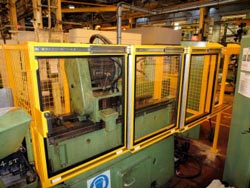
Posted to News on 18th Aug 2014, 15:57
New guarding standard tightens requirements
This article from TUV SUD Product Service outlines some of the changes expected when the machine guarding standard EN 953 is replaced.

The European standard for fixed and movable machine guarding, EN 953, will soon be replaced. In theory, the new standard will only apply to manufacturers of machinery. However, in reality, it will also apply to anyone who is adding new or additional guarding to an existing machine. Therefore, the machine user will need to be aware of the changes, as they may be producing guarding themselves or, at the very least, specifying it from a supplier.
It is clear that the new machine guarding standard, EN ISO 14120 Safety of machinery - Guards - General requirements for the design and construction of fixed and movable guards, is more prescriptive in its requirements, leaving less room for interpretation by individual machine builders. Section 8 of EN 953 now becomes Section 7 (Verification of the safety requirements for guards) of the new standard. For the first time, this section specifically refers to verification methods. These are outlined in Annex C, which covers guidelines for the selection of guards according to the number and location of hazards and provides a flow chart to assess the selection of guards according to the number and location of hazards.
If there is a safety problem further down the line, and a machine builder cannot demonstrate that they followed the very specific guidance in Annex C, it might be argued that due diligence has not been followed and legal action may be taken.
Guarding selection guidance
Annex A in the EN 953 now becomes Annex B (Guidelines for the selection of guards against hazards generated by moving parts) in EN ISO 14120. This provides a flow chart for the selection of guards against hazards generated by moving parts. In both standards, the flow chart asks: "Is access required only for setting, process correction or maintenance?" In the old standard the answer 'yes' would prompt the next question: "Is access required more than once per shift?", while the new standard simply asks: "Is frequency of access high (more than once per month)?"
This, of course, has significant implications because a typical manufacturing day may include three shifts, each of which may require a different machine configuration, potentially more than 1095 alterations a year. However, the new standard asks manufacturers to only consider if access is required more than twelve times per year, whereas the old standard is more focused on the frequency of individual shifts.
Beyond this, the options in both Annex B and C of the new standard (which were A and B in the old standard, respectively) have changed. For example, in the previous standard where access was required more than once per shift, a fixed guard, or a movable guard with interlocking device or without guard locking could be used. However, the new standard only allows a fixed guard to be used if replacement and removal is easy. This, of course, has significant implications for machinery that is currently in production, as it may require additional costs for part redesigns on new builds.
Section 6 of both standards covers the selection of types of guards; both list the most important selection criteria as:
- the probability and foreseeable severity of any injury as indicated by the risk assessment;
- the intended use of the machine
- the hazards present at the machine;
- the nature and frequency of access.
Misuse and defeat of guards
However, the new international standard introduces the concept of 'the foreseeable misuse and defeat of the guards'. This new element requires a machine builder to consider more deeply how an operator could disable a guard or interfere with a machine in order that it continues to operate without guarding, ie looking beyond the obvious intended use. A thoroughly documented risk assessment is therefore vital to not only highlight where guarding is required, but also how the machine builder has considered that it may be defeated.
Section 9 of EN 953 now becomes section 8 (Information for use), with 8.3 (Installation) being greatly expanded. Whereas the old standard simply stated: "Instructions shall be supplied for the correct installation of guards and associated equipment", the new standard will make machine builders think more deeply about how installation is approached, with specific requirements for fixing when guards are attached to a structure.
EN ISO 14120 will require that consideration is given, but is not limited to:
- fixing to a floor
- assembling of movable guards
- number and types of fixings
- compliance with other relevant standards
Within the new standard, Section 8.5 (Removal of guards) has also been expanded from requiring that: "information shall be provided indicating any actions to be taken before guards may be removed safely" to a more detailed list that includes requirements on the appropriate use of tools.
While the material changes to the new guarding standard are not significant, some elements are now more thoroughly detailed. This will help to make risk assessments less subjective, as it leaves less room for interpretation by individual machine builders. However, as the new standard's sections and annexes have been renumbered, even those businesses that already have solid due diligence procedures in place will need to embark on a full update of any documentation - which will be no small task.
For any advice and guidance relating to the interpretation of the replacement for EN 953, please contact TUV SUD Product Service.






























